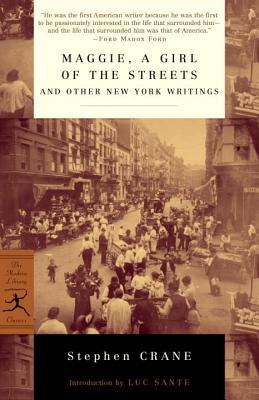We return to the 17th Street book blogs this month by moving far away from the world of Fifth Avenue mansions and upper class society for a journey into the slums of old New York. Although Caleb Carr has not, to my knowledge, referenced the work of late nineteenth century journalist and novelist Stephen Crane as an influence for the Alienist books, readers of Crane’s atmospheric New York novellas will instantly recognise the same city that was so vividly portrayed in The Alienist and The Angel of Darkness. Given that I have utilised the 2001 Modern Library Classics edition of Crane’s New York writings for this blog, which contains the definitive versions of his novellas Maggie, A Girl of the Streets (1893) and George’s Mother (1896), along with a comprehensive selection of his other Bowery tales, we will be considering both of Crane’s New York novellas together in the following post, rather than just focusing on Maggie, the most famous of the pair.
What’s it about?
Maggie, A Girl of the Streets opens with a scene that would not be out of place if glimpsed in one of the Alienist books. Jimmie, “the little champion of Rum Alley,” is embroiled in a fight with a gang of street urchins from nearby Devil’s Row. Battered and bruised, with blood “bubbling over his chin and down upon his ragged shirt,” the fight only comes to a halt when Jimmie’s father arrives on the scene, obtaining his son’s obedience through violence of his own. As this opening scene suggests, life in the family home is no less frightening than life on the streets for Jimmie, his quiet older sister, Maggie, and his confused and neglected baby brother, Tommie. With a drunken father and an equally drunken, vicious mother who can match her husband blow for blow, Maggie, A Girl of the Streets chronicles the stories of Jimmie and Maggie as they grow up to find their own places in the poverty-stricken world that surrounds them, with one child embracing their fate while the other tries in vain to search for a way out.
In George’s Mother, the sequel to Maggie, A Girl of the Streets, we return once more to the tenement building of Jimmie’s family. Unlike Maggie, however, George’s Mother explores the inner struggles of George Kelcey, the hard-working son of a loving, patient, and temperance supporting mother who has only one fear for her sole surviving child: that he will succumb to the vice that lurks on every street corner in their neighbourhood, and turn to drink. Through these contrasting family portraits, Crane vividly demonstrates the powerful hold that alcohol maintained in the lives of the poor in late nineteenth century New York, and doesn’t shy away from chronicling its effects on the lives of children and adults alike, both inside and outside the family home.
My thoughts
My first impression upon reading the opening lines of Maggie, A Girl of the Streets, along with George’s Mother following it, was that I had once more been transported back into the world that John Moore and Stevie Taggert so vividly describe in The Alienist and The Angel of Darkness. Once again, the reader is there, looking down on the dusty streets from surrounding tenement buildings as we hear the howls arising from a gang of children hurling stones at a small boy who is standing atop a heap of gravel in a vain attempt to defend the honour of Rum Alley. Similarly, in George’s Mother we find ourselves “in the swirling rain that came at dusk” on a broad avenue glistening “with that deep bluish tint which is so widely condemned when it is put into pictures,” through which we witness,
George’s Mother, Chapter I
… the endless processions of people, mighty hosts, with umbrellas waving, banner-like, over them. Horse-cars, aglitter with new paint, rumbled in steady array between the pillars that supported the elevated railroad. The whole street resounded with the tinkle of bells, the roar of iron-shod wheels on the cobbles, the ceaseless trample of the hundreds of feet. Above all, too, could be heard the loud screams of the tiny newsboys, who scurried in all directions. Upon the corners, standing in from the dripping eaves, were many loungers, descended from the world that used to prostrate itself before pageantry.
Although Crane’s masterful portraits of the streets he knew so well are reason enough for any Alienist reader to pick up these stories, it is his examination of the role that alcohol played in the lives of the poor, and its contribution to other forms of vice ranging from violence to prostitution, that make these stories so compelling.
| Continue reading →

